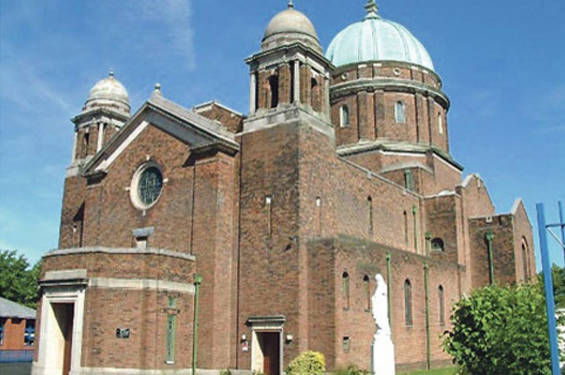This website uses cookies
This website uses cookies to enable it to function properly and to analyse how the website is used. Please click 'Close' to accept and continue using the website.



November 2009 - Saint Peter and Saint Paul’s Church, New Brighton
Sandy and Norris, by Aidan Turner-Bishop
This month marks the 30th anniversary of the founding of the Thirties Society, which was to go on to become the Twentieth Century Society. To celebrate this anniversary November 2009’s Building of the Month draws attention to an important current case of the Society, a church built in the 1930s.
The large domed church of St Peter and St Paul dominates New Brighton opposite Liverpool. It’s a prominent landmark on land and sea, visible across Liverpool Bay. It is recorded on a marine navigation chart and sailors are said to have nicknamed it the ‘Dome of Home’.
The church was built in 1932-5 to the designs of E Bower Norris of Sandy and Norris, architects of Stafford and London. The practice, which included F M Reynolds, specialised in ‘traditionally built’ Catholic churches – mainly in the English North and Midlands – such as Sacred Heart, Blackburn, and St John Baptist, Rochdale, which is also impressively domed. They and their clients often favoured a solid Byzantine or Roman Gesù style, perhaps influenced by priests’ seminary training in Rome (often they were Jesuits), and a desire to assert the arrival in the suburbs of a confident and prosperous second generation of Roman Catholics, children of Irish immigrant parents living in the inner cities.
Ss Peter and Paul’s Classical Renaissance copper-clad dome has a reinforced concrete shell with red brick facings and ashlar limestone dressings. The church’s plan is basilican with an impressive, high quality interior. The sanctuary high altar has a classical marble reredos. Transept chapels have marble altars and columns. George Thomas, sculptor, of Liverpool designed the Stations of the Cross in art deco style. The centre aisle, with flanking arcades of tall semi-circular arches, is beneath the concrete barrel vault. Pevsner described it as “very large and ambitious, and a fine landmark, but not really valuable as architecture”. He felt that the planing away of relief (perhaps to reduce costs) was “modern by negative means”. Nonetheless the church is impressive and well-loved locally. It was listed Grade II in 2003.
The Wirral is in traditional Cheshire and thus in the Catholic Diocese of Shrewsbury. In 2007 parishioners were distressed to hear that the Bishop of Shrewsbury had decided to close the church and merge the remaining congregation with that of a neighbouring Church of England parish. The Diocese claimed that numbers at Mass were declining but this is unsurprising since the only weekly Mass had been reduced to one at 8.30am on Sundays. The church was closed at other times. Prohibitively expensive repair costs for the large building were also cited as a reason for closure. There was talk of demolition and redevelopment. The Diocese had held “exploratory” meetings with developers Urban Splash. At that time Merseyside was experiencing a property development Klondyke and anything seemed possible.
A local campaign group called SOUL – Save Our Unique Landmark – was set up to oppose closure and it attracted strong support from local people and politicians and from the Twentieth Century Society. SOUL pointed out that funds for repairs were available but that the Diocese had not used the money for these purposes. The group also undertook small repairs to maintain the building despite the reluctance of the Diocese to do so. However their protests were in vain and the church closed on August 17, 2008. Perhaps the Diocese may have expected the church’s condition to deteriorate to the point where demolition was inevitable, clearing the site for lucrative redevelopment. However the authorities had not reckoned on an economic recession and the dogged persistence of SOUL who appealed through the Catholic canon legal system to the Vatican. In August 2009 Archbishop Piacenzo of the Congregation of Clergy ruled that the closure broke canon law and that it was ‘null and void’. It’s not the first time that the Vatican has criticised Bishop Noble; previously Monsignor Carru had called the idea of moving Masses to an Anglican church “a novel plan” that would “naturally be of concern to this congregation”. This is strong language in Vatican Speak. The Diocese can appeal against the decision but it would be brave to do so.
In the meantime Ss Peter and Paul stands closed and vulnerable to vandalism and the climate, despite repair funds being available and a congregation yearning to return. Redevelopment is unlikely in a long recession so why not repair the listed church, as is legally required, and allow the parish to flourish in its fine building?
Look for past Buildings of the Month by entering the name of an individual building or architect or browsing the drop down list.

Become a C20 member today and help save our modern design heritage.